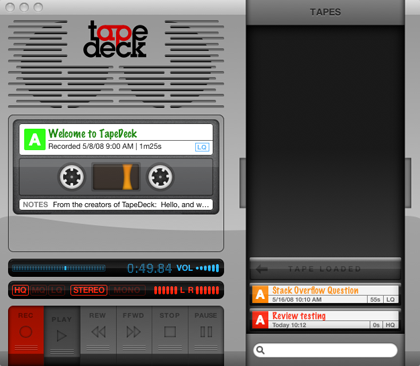Software Review
TapeDeck 1.0

Developer: SuperMegaUltraGroovy and ToastyCode
Price: $25
Requirements: Mac OS X 10.5. Universal.
Trial: Feature-limited (limited recording time, low quality only, slower playback)
Back in the 1970s and 1980s, cassettes ruled the personal recording world. Familiar button controls like REC, FFWD, REW, and STOP defined an interface that carried over to VCRs, DVDs, and so on. It also meant personal expression limited only by the amount of available blank tape. The new Mac OS X application TapeDeck burnishes that memory by transmogrifying a portable recorder into a windowed application.

TapeDeck’s interface combines a cassette recorder on the left and searchable tape library on the right.
TapeDeck supports one main feature. Start recording, capture the audio, stop recording, and file it as a “tape” in your catalog. Once there, export tapes to iTunes or attach them to e-mail as desired. Unlike plastic cassettes, there’s no overwriting of tapes; TapeDeck creates a new tape automatically each time you record. The only limit to your recordings will be the available disk space.
Interface
Even younger users unfamiliar with the original cassette tape recorders should understand the icons and titles for TapeDeck’s controls. One click starts a recording, and another stops it. A numerical readout shows elapsed time, and the tape label displays your notes, made by selecting the title or NOTES section of the tape itself.
REW, FFWD, and PAUSE work like expected, though with a caveat. If you’re already moving the tape one direction or have paused it during playback, you must press PLAY prior to using another control. Speaking as someone who owned several real-life decks, immediately changing directions would more closely match the real-life behavior.
The “loaded” tape provides most of the interaction, but the right-hand catalog offers two simple features. You can select a tape in the catalog list to load it or type in the search box to narrow down your list of tapes based on the title or notes field.
The interface isn’t perfect yet. Though the application clearly displays the current recording quality (high, medium, low) and type (mono or stereo) setting in red, it’s hard to see the unselected choices, and they don’t look like buttons. First-time users need good cues for options they control, and this one lacks polish. (The developer could fix them by changing the interface to 2- or 3-position switches, something common on tape decks.)
Other Features
TapeDeck doesn’t allow you to record over (or erase) previous sessions. Each recording creates a new tape, which sacrifices some freedom to edit partial recordings. In the same vein, it relies on Apple’s AAC format for easy transfer to iTunes. Recording into a compressed format does reduce file size, which helps when you e-mail or upload the final product. Unfortunately, that also prevents you from making studio-level recordings. Its “high quality” stereo setting is 128kbps, the same bitrate used by the lower quality AAC files at the iTunes Music Store.
(If you want uncompressed recording quality and the ability to edit afterwards, check out the open source project Audacity for a cheaper and somewhat harder-to-use option.)
A few features depart from the physical tape model and require that you poke around (or read the Help file) to uncover.
- Organize your tapes by color-coding the large “A” next to your tape. Click on it to cycle through the available colors.
- TapeDeck can record in the background. Configure REC and STOP hot keys for this, for example while reading a speech or presentation.
- There’s a blue bar next to the duration counter. Click along it to skip to that part of the recording without using REW or FFWD.
For a 1.0 program, TapeDeck runs pretty well. I did see the error message “Untitled 1.m4a does not exist” occasionally when deleting unneeded tapes. Fortunately, it only happened a couple of times.
Now, How Much Would You Pay?
TapeDeck records just like a cassette, apart from a few exceptions noted above. The unregistered version allows you to make test recordings and $25 gets you the whole program.
With the exception of applications like Audacity and Audio Hijack Pro, most audio recording applications cost big money, so this is a relative bargain. On the other hand, it records to the compressed AAC format and doesn’t include an editor, so it needs other applications to be really powerful.
You need another program to edit and “finish” a recording, so why do I like it so much? TapeDeck’s interface wisely capitalizes on the familiar, in sharp contrast to the over-powered applications I’m used to seeing in the audio world. Creative types can distribute a tune or audio blog moments after pressing STOP. I can capture and organize business notes with a minimum of fuss before and after. That’s “excellent” to me.
Reader Comments (0)
Add A Comment